|
As part of The Improvisation Center, our homestead must support us in our quest to become self sufficient. This
of course includes food production, and what better way to accomodate that than to have our own gardens?
Since the ground here is piss poor for growing anything but crabgrass and weeds, we had to resort to raised beds filled
with top soil and manure, among other things, to set the stage for our outdoor supermarket. The raised beds are made
of 2x10 boards, with seven of the eight gardens being 12' x 4' in size, with the eighth one being 10' x 4' in size, to provide
an opening for the gate that goes around the gardens.
Right now the gardens are in a little bit of an unorganized state, with some exceptions. We have one bed dedicated
to growing onions; another for strawberries; another for a number of greens, which include broccoli, collards, and leaf lettuce;
one for potatoes; and another for lima beans and green peas. The other remaining gardens have a mixture of tomatoes,
peppers, kale, cauliflower, squash, and carrots.
We are trying to do this whole thing in the organic state, trying to stay away from any artificial fertilizers or sprays.
For fertilizer, we've used manure, as already stated, grass clippings as mulch, and fish guts as another filler for the soil,
along with fish gut tea and fish emulsion as spray on fertilizers.
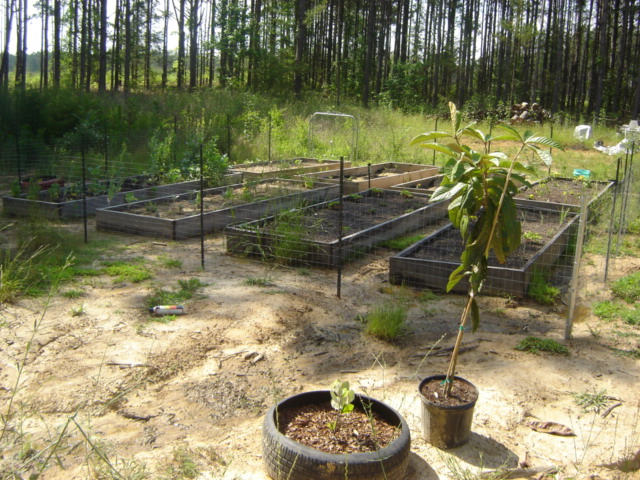
|
| The raised bed gardens, all set up and doing their job of growing our future food supply |
Another part of our produce stand is a small orchard of fruit trees. Most of these trees are dwarf or semi dwarf
trees, with the exception of one of the peach trees, which if allowed to grow unchecked will grow to a large size. Right
now we have several apple trees of different varieties, a couple of plum trees, a pear tree, three peach trees, a nectarine
tree, a fig tree, a pomegranate tree, two apricot trees which at this stage are still the twigs that they started off as,
and a couple of cherry trees.
The pitted fruit trees (peach, plum, nectarine) are planted in tires over a hole dug in the ground, so the root ball
is above ground so as to keep the roots from becoming super saturated when it rains and water runs down across the land, filling
the holes up. We had an issue where after a few rains, the holes where our old peach trees were would fill with water,
turning the dirt in them into a soup that we believe drowned the roots of the trees killing them. So hopefully the tire
idea will keep the root system well drained, while still allowing them access to water and room to expand. The rest
of the trees are doing OK, just growing up merrily.

|
| Shot of the fruit tree orchard |
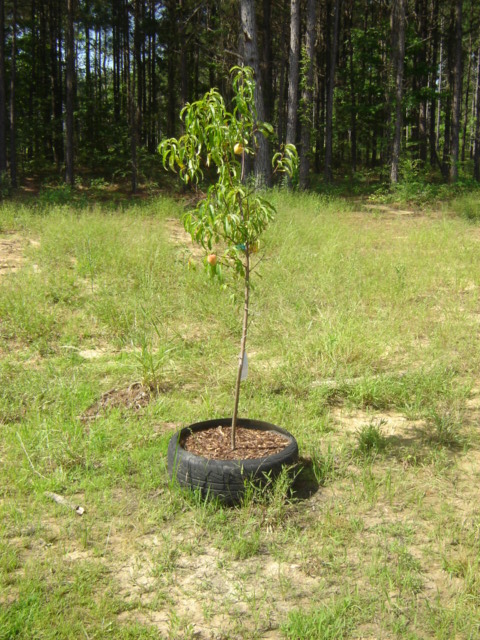
|
| A peach tree, planted inside a tire over a large hole in the ground. |
We also have a number of citrus fruit trees. Three of them, two lemons and a grapefruit, are dwarf trees approximately
3' tall and in pots. All three of these trees have multiple fruits growing on them at this time. The others, which
are oranges, among a few others which I personally forgot since theyve been long planted, are little 8" tall houseplants in
their own right, planted in large pots and buckets for the time, while they grow. We also have a dwarf banana "tree"
too, also in the pot. We have plans for these trees though, when we build our garage workshop, it will have a greenhouse
attachment on the rear of the structure, which will be home to these trees as they grow into maturity. We will have
to put them in the greenhouse so as to keep them from freezing to death when the height of winter comes.
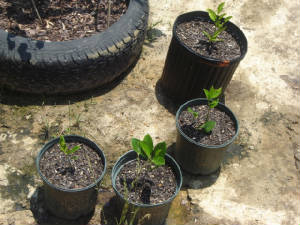
|
| A few of the fledgling citrus fruit trees in pots |

|
| Dwarf lemon trees in pots among the grapes |
Last but not least in the permanent produce setup are the grapes and berry bushes. We've set up a series of tire
beds with a hole dug into the ground underneath them to accomodate grape plants that we've gotten when they were still twigs
or small plants in the spring. Right now most of the grapes have grown into a pretty large size with several of them
growing clusters of grapes on them that are only a month to maturity. We did the same setup with the grapes as we did
with the peach trees so the root systems can stay well drained while still having access to water retained in the dirt filled
holes. We also covered the dirt in the tires with pine bark mulch to help retain moisture in the dirt so as to not need
to water the plants as often.
We have several species of grapes, along with a muscadine, and a raspberry, all grown pretty big now, in the tires.
Off to one side of the raised bed garden area is the berry bush grove, that consists of several blueberry bushes, one pretty
large, two of an intermediate size, and several that are fledglings. The three larger blueberries have a large number
of berries on them awaiting maturity. Amongst them are our native Southern friends, the blackberry. We have a
couple of blackberries that we bought from a local nursery and some more that we transplanted from the edge of the woods on
the property here. The nursery blackberries have already been producing berries that we've been picking off and eating
on occasion. Last but not least in this little area are a few raspberry twigs that are slowly growing.
We do have plans on expanding the berry grove as soon as we clear away some of the high bush and weeds that have proliferated
since last summer and this spring. The whole idea is to have enough berry bushes around that we will still be able to
harvest a sizable amount of berries, even after the snakes and birds have their share. We cant guard the crops 24/7
so the only other way is to produce an excess so we can at least have enough for ourselves each year and the remainder can
be shared with friends & family or sold at the flea market or farmers market.
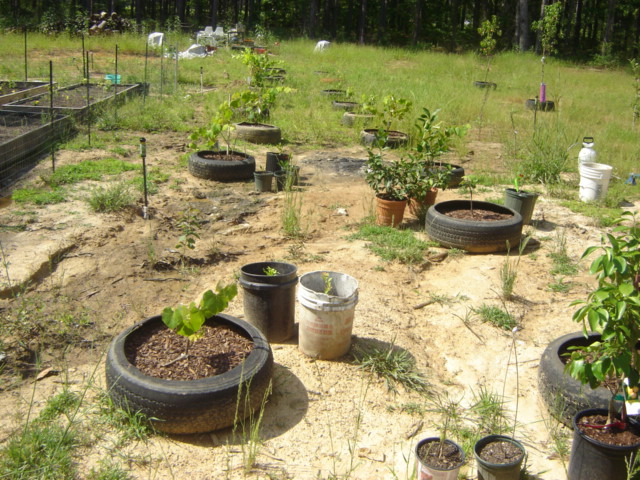
|
| Some of the grape sets, planted in tires over a hole |
UPDATE:
At this stage in our garden development, we did a number of changes. The first thing was the establishing of a
ground level garden that measures approximately 15 ft wide by about 40 feet long, directly south of the orchard. This
area was built up over the course of a winter by spreading countless bags of grass mulch and dead leaves along with kitchen
scraps and other organic trash, including wood ashes from the stove and bags of compost and topsoil. Afterwards this
was all tilled into the native ground. With all of this it still wasn't enough to make the soil workable enough when
it gets soaked then dries again.
What I ended up doing when I went to plant everything was create bowls in the dirt to fill with compost and topsoil with
which to hold the seedlings so they can get a good headstart with their root systems before having to divert more energy into
pushing into the thick clay mud soil mixed with organic material.
I planted a number of tomato and pepper plants, some squash, watermelons and a pumpkin, some peanuts and corn plants,
some cucumbers and potatoes, a basil plant, some okra, and bean plants. After a good month and a half passing, the squash
plants are already huge and producing squashes, the tomatoes are over 2 feet tall and producing tomatoes. The peppers
are moving along well, same for the cucumbers, okra, corn, watermelon and pumpkin. Many of the potatoes are slowly moving
along as well. The beans are kind of sitting there stunted while the basil is growing well too. The peanuts are
slowly growing along as well. Most likely I will have to start hitting everybody with some good doses of fertilizer
to get them really growing through the shitty soil.
Before we went on vacation to Chicago we installed a fence around the garden to keep the dogs, among other things, out
of the area. This fence is the same as what's around the raised beds-cheap chicken wire with T posts and chain link
fence posts at all four corners. This fence will lose the side facing the orchard when we put a fence completely around
the orchard later in the year.
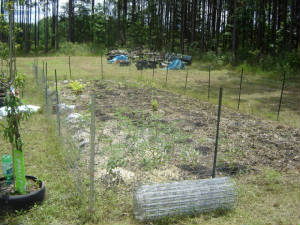
|
| Ground level garden with fence around it, note large plants |
Another thing that I did in the garden around each plant was apply shredded newspaper around them to serve as mulch.
I also added more dirt around the plants to create mounds to help add more nutrients to the plants as well as provide more
growing medium for the expanding root systems. The newspaper served to retain moisture in these small mounds of dirt,
which probably played a vital role in the plants growing like the have and still do.
The next thing I did was transplant all of the grape tires and the blueberries and blackberries to positions among the
fruit trees. The theory behind this idea was that in the orchard, since the fruit trees were spread out anywhere from
10-15 feet apart, there is a lot of open ground that was doing nothing but growing grass & weeds.
I first transplanted the grape tires and lined them up neatly starting on the east end of the orchard. After getting
all of the grapes moved, I then started working on the blueberries and blackberries. Instead of planting the plants
directly into the ground I planted them into tires as well, so as to match up with the grapes and to allow for drainage on
the plants. After getting this done, I added a few more plants that we picked up in Chicago and just recently another
grape. At this point the entire east half of the orchard has tires planted among the fruit trees. All of the ground
is effectively utilized with walkways big enough to move a wheelbarrow through. In the future we will spread a thick
layer of mulch on the ground to kill the grass and provide for a neater garden/orchard.

|
| Tire gardens transplanted to orchard |
Among the grapes and berries, I also had to transplant a few trees that were also planted in tires close to the grapes.
These were planted on the west end of the orchard in the middle of the squares of four other fruit trees. One of the
transplants also replaced another tree that was long dead.
My next plan will be to transplant the raised beds to the west end of the orchard. After doing this we will dismantle
the old raised bed garden fence, posts and all, and use the materials to build the fence that will go around the entire orchard
area. By doing this we will keep the entire area protected from critters.
UPDATE: CHANGES TO OVERALL GARDEN PICTURE...
2-7-10:
At this present time, some changes have been made to the garden as a whole here at our homestead.
In trying to keep up with the theme of not wasting space, and trying to be as efficient as possible with the use of space,
we went ahead and did some more "merging" of our garden layouts.
For those of you who keep up with The Improvisation Center, you may remember how we took the tire gardens
that housed the grapes and berry bushes and squeezed them all together among the fruit trees, therefore utilizing a much smaller
land footprint, while still being able to sufficiently sustain all of the plants. In the orchard where all of this was
set up, we purposely left half of the area open, with the intent on moving the raised beds to those open areas, using up that
empty space, and therefore combining everything that much more so, into a smaller space, so there will be less water usage
through less sprinklers.
We were able to set up five full size (4x12) beds in the open area, one 4x9 bed and one 4x5, obviously cut
down from the other larger beds. We were able to recover most of the dirt for filling these new beds, except for the
4x5 bed. We even managed to transplant our rosemary bush into its own tire among the raised beds.
Many of the veggies managed to survive in the neglected beds. We recovered many onion and garlic plants
that were still green, however bulbless. We transplanted them in the hopes of them growing into final products later
this year. We also transplanted several kale and a few large collard green plants that are doing very well in this cool
climate. All of the strawberries were recovered and transplanted into their own garden, this time planted a little closer
together, to allow for more strawberries to be planted later this year. By doing this we only used maybe half of a 4x12
bed for the strawberries.
Our next move is going to be the placement of more tires in the orchard/garden area. Among the raised
beds there is room for several tires, all of which will be used to raise more veggies, like potatoes or tomatoes, items that
require a fair amount of space, either above or below the ground. In the rest of the orchard where there is extra space
for tires, we will probably do the same with the types of plants we will plant, if for no other reason we choose not to just
add more grapes or berry plants or fruit trees in those open areas.
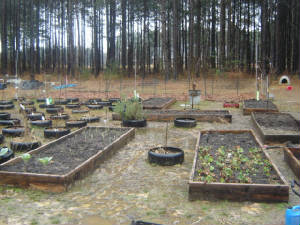
|
| Raised beds in their new location in the orchard |
The next thing that we did was move all of the fences. Since we dismantled the old raised bed area,
which included the fencing, we had more than enough material to establish a new fence around the orchard to help protect everything
from the stupid dogs (ours mainly) who find it compelling to dig up every damned thing that isn't anchored down!!
We pulled up every fence post and put down our round posts at the opposite corners of the orchard from the
ground level garden (which already had its own fence around it, then put t-posts in the ground between the round posts.
We also moved the gate and its supporting post to the northwest corner of the orchard, right along the driveway, for quick
access.

|
| Fence gate setup in its new location |
With the gate and the posts all set up, we then dismantled the part of the ground level gardens fence where
it divided the garden from the orchard and pulled that fence around to the east side of the orchard and tied the mesh up to
those posts, having just enough mesh to reach the northeast post.
We then took one of the lengths of mesh fencing from the old raised bed fence and tied it to the northeast
post and tied it all the way along the north side of the orchard up to the gate's inner post, leaving only a couple of feet
of extra mesh, this was looking very promising.
Lastly, we took the remaining length of old raised bed mesh and tied it up to the northwest post and ran
it over to the ground level garden's northwest post, tying it up along the way, with only a few feet of extra fence left there
as well. Perfect.
To conclude, we were able to get the fencing established pretty quickly, with a minimum of leftovers, and
we only had to pull up a couple of the round posts a couple of times to re-seat them in order to tie the mesh up. Everything
turned out nicely with this one.
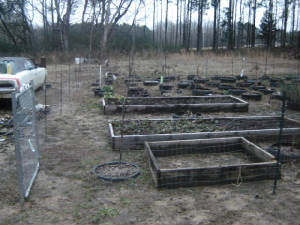
|
| Shot of garden from NE side, note charger to left |
With the old raised bed area cleared away, the only thing thats left now is to dig up the unneeded sprinkler
heads and pipe protrusions, then readjust the current ones, including the timer, so we can get maximum use of the water that
is sprayed on the orchard residents.
The old raised bed area will be allowed to grow back over by the native plantlife, until we decide on a
use for that area in the future, maybe small pastureland for free range chickens or goats? Who knows.

|
| Old raised bed area, stripped, looks like the site of a big burnout |
9-18-10:
Its been a while since the last garden update but things have actually been going good this year. We planted a
number of things and expanded the garden some more in order to get the optimum use of the space available.
Another thing that is being done is the preparation of the area of the garden/orchard that will serve as the "ground
level" garden. This area for the last year has been covered in a host of things intended on conditioning the ground
for tilling and later planting next season.
Everything from bags of leaves, bags of dirt from Lowes, compost from our compost can, even horse manure from our neighbors,
has been dumped on this area and allowed to compost over the year.
One thing about the horse manure on the ground though, when our neighbor dumped the few tractor scoop loads,
instead of spreading them out, I planted several sweet potato plants in the mounds. Needless to say, they've grown so
thick and fast that they created a carpet of sweet potato vines.
A new addition we've acquired is several dump truck loads of fresh ground mulch, mostly pine branches, but mulch nonetheless,
given to us by a tree trimming contractor that came through our area trimming the trees around the power lines. This
stuff has already started composting, evident by the steam being emitted from the piles in the cool early morning, or
when I scoop mulch from the piles. The plan for this stuff will be placing a thick layer of this stuff on the ground
level garden then till it in, then place another thick layer of it on the tilled ground, and before planting next season the
next layer will be tilled in just before planting.
For the time being the mulch has been getting spread over the walk ways between the raised beds and tires within
the fences of the orchard/garden, as well as around the moist areas in the yard too. Theres' a bunch of areas within
the garden that are sloppy from watering the plants and so the placement of the mulch on these moist areas will hopefully
take care of that problem so as we go through the garden to harvest stuff, we won't get our shoes sloppy and our feet
wet.
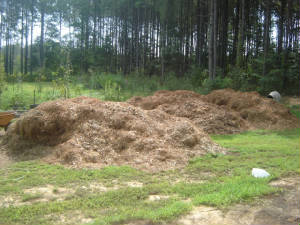
|
| The mounds of pine mulch cooking in the sun |
As far as our plantings, one of the raised beds is again, dedicated to strawberries, another one was dedicated to onions,
which for the most part have already been harvested with a few smaller ones left behind to grow next years. That garden
is currently being used for some cauliflower or broccoli, I forgot which, might be both.
Another raised bed was filled with hay and used for potatoes, which didnt do too well, we'll try again next year.
The next raised bed was used for mostly okra, with some potatoes, which died early, but the okra is growing like mad,
the plants are actually over 6 ft tall!
The next raised bed has tomatoes, bell and hot peppers, all of which is doing well. The tomatoes are still producing
tomatoes, while not as fast as they were earlier this year, they're still lush and producing tomatoes. Same goes for
the peppers.
The next bed has tomatoes, eggplants and jalapeno peppers, all of which are also doing well, with the same results as
the last bed, not producing as fast but still producing nonetheless.
The last bed has cucumbers and had squash in place. After a killer heat wave, the squash died back and most of
the cucumbers died back, with the remaining kind of in a stalled state. Earlier this year they were putting out like
mad though, with vines stretching for several feet all over.
Many tires have been placed on the ground between the fruit trees, in close proximity to facilitate more blueberries,
grapes, muscadines, blackberries and even some new trees to replace those that have died.
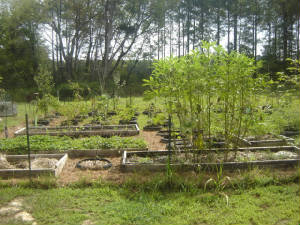
|
| A shot of the garden with the big ass okra in the foreground |
As can be seen in the last picture, the mulch lies between the beds in the walkways. Also planted in the bed
where the squash and cucumbers were at is some rutabaga plants as well. Along with the cauliflower and broccoli, we
are starting the cool weather plants.
Another aquisition from Lowes recently was a number of apple and peach trees on clearance, got em for like $5 a piece!
So we literally started a whole new row of trees on the east side of the orchard, outside of the fence of course. The
row contains six trees total.
With this, we will be putting down more tires for more bushes next year while at the same time expanding the fence to
enclose this new row of trees.
11-25-10:
At this point most of the garden is dying or has died back already, which is expected, but we have planted some cool
weather stuff at the beginning of fall, in order to get a little more before the winter comes, doesn't make sense to waste
any of the potential growing time available. We planted some rutabagas, lettuce, broccoli, and cauliflower. For
some odd reason, we never seemed to have much luck with the broccoli/cauliflower, but the lettuce and rutabagas are doing
real well. While the lettuce hasn't turned into the "heads" they were supposed to, the foliage is thick enough that
its still more than edible and suitable for the applications we use them for (BLT sandwiches and burger garnishings).
The rutabagas have grown rather fast and are probably close to harvesting now too.

|
| Rutabaga plants, you can probably see one just below surface of dirt on lower left |
Another thing that we did was harvest the sweet potato crop after the plants died back when a cold snap came through.
To recap, we had three piles of composted horse crap dropped off by our neighbors, to which we planted nine sweet potato seedlings
in them as they lay. We were definately surprised by what we unearthed.
While many of the spuds were chewed on or otherwise damaged, they were still massive enough that we could cut off the
damaged portions and still have plenty of spud left to do what we wish. While there won't be any baked sweet potatoes,
we will still be able to do things like make pie or even fries out of them.
These spuds are damned huge! As we went through the ground we would find some and try to pull them out only to
find they were over a foot in length. When all was said and done we ended up filling a milk crate over the top with
spuds along with two 5 gallon buckets, also over the top. We ended up taking a large Rubbermaid container of about 30
gallons capacity and lined it with dry pine straw from our mounds and laid the spuds out on the bed of straw, filling in the
gaps with more straw, then starting another layer of spuds until we had the container filled up. This is to help preserve
them long enough to give us time to eventually get to them. We did give some to another neighbor and a cousin, and plans
are "cooking" to make some pies for the freezer too.
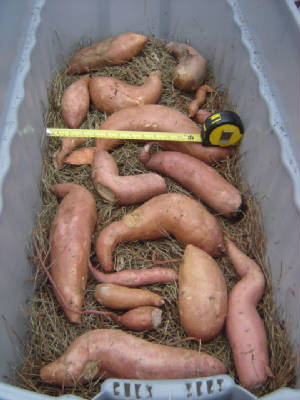
|
| Sweet taters in container w/tape measure pulled to 13-14" for comparison |

|
| Second layer of taters laid out. |
We do have some onions that just don't seem to want to die (or grow for that matter) planted along with the lettuce and
brassicas, so we'll see what happens with them as well. We harvested the remainder of the green tomatoes and peppers
that were present; the pepper plants, while still green, will probably not last much longer, especially now that some super
cold nights are on the horizon.
Now's gonna be time to clear the dead plants out and dump them on the ground garden plot and eventually till the whole
mess into the ground to get the plot started in its conditioning for next season. We will also be emptying our compost
can into the cleared raised beds to give them a good dose of conditioning for next year as well, plus to start a fresh batch
of compost.
Other than that, there's not much more going on for the garden, so with our second good year documented, we will cease
to post more with the gardens, unless we do some other improvements with the whole plot that we believe you readers/viewers
may be interested in. Those updates will be posted in the "garden extras" page of this site. Until then, happy
homesteading!!
|
